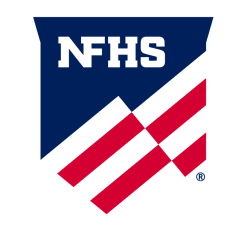INDIANAPOLIS, IN (April 14, 2020) — Providing more clarity on a proper race finish and official timing procedures are among the noteworthy high school swimming and diving rules changes for the 2020-21 school year.
These topics were among those discussed by the National Federation of State High School Associations (NFHS) Swimming and Diving Rules Committee at its annual meeting March 22-23, where a total of six rules changes were recommended for approval. The rules meeting was held in an online format to comply with current health safety guidelines. All recommendations were subsequently approved by the NFHS Board of Directors.
Rule 1-1-1 was edited to profile the end wall in more detail. Previously described as “the walls perpendicular to the race course,” the new definition broadens the term to include “the vertical portion of the pool, contiguous surface of the deck and overflow gutter, the front of the starting block or platform, or the touchpad at the end of the course.”
“This additional language provides clarity on what constitutes the end wall,” said Sandy Searcy, NFHS director of sports and liaison to the Swimming and Diving Rules Committee. “The 2019-20 rules book changed the definition of the finish of the race by permitting the swimmer to finish at the end wall, not the touchpad. That change necessitated a more concise definition of the end wall.”
The end wall was also referenced in the change to Rule 6-3-2, which specified acceptable methods for measuring “official” times. When a legal touch is made with the end wall to signify a legal finish, buttons and/or stopwatches, which are commonly used for backup timing, are now explicitly listed as alternatives to touchpads.
Clarity to the usage of backup timing devices was also addressed in a change to Rule 6-3-4. Whereas official times could previously only be taken from backup mechanisms in the event of a malfunction to the automatic timing equipment, the rule’s new language was written to incorporate all other instances where an official time is not properly recorded.
“This rule change more accurately describes the protocol for determining an official time when the competitor contacts the end wall and not the touchpad,” Searcy said. “Backup buttons or stopwatches may need to be used in situations where the swimmer does not activate the touchpad or the touchpad malfunctions. This phrase clarifies conditions when the swimmer does not touch the touchpad initially.”
New articles were added to Rules 1-4-5 and 1-4-6 to differentiate the terms diving “round” from diving “session” and bring consistency to those definitions. Used frequently throughout Rule 9 of the rules book, a diving session refers to one of the various levels – preliminary, semifinal and final – within an 11-dive competition, while a diving round is the completion of one dive by each participant. Additionally, divers are now permitted to practice in between diving sessions at the discretion of meet management.
Alterations were made to the uniform code under Rules 3-3-3 and 3-3-4c regarding accepted and prohibited manufacturers’ logos. In addition to the mark signifying approval from the international governing body for aquatic sports, FINA, the USA Swimming checkmark logo is now considered an acceptable suit marking.
“This rule is a clarification of what the swimming community may see on suits this fall as a result of a rule change made by USA Swimming,” Searcy said. “A small checkmark will be positioned next to the FINA marking on some suits and is not considered as an additional manufacturer’s logo or advertising.”
Finally, headings were added to Rules 9-3-3 and 9-3-5 to help explain the two-step process for entering divers at championship meets. The process includes entering the divers and swimmers’ first and last names, events and school affiliations onto an official team entry document, and then submitting the document at the time and place specified by the meet manager. Subsequently, divers will submit a scoresheet/dive list to complete the process of their entry into the diving event.
According to the 2018-19 NFHS High School Athletics Participation Survey, swimming and diving is the 10th-most popular sport for boys with 136,638 participants in 7,704 schools, and the eighth-most popular sport for girls with 173,088 participants in 8,007 schools.










